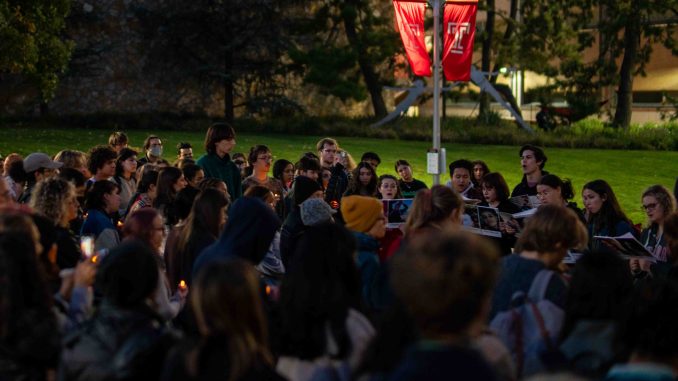
Dozens of voices broke out into song, cries and cheers as nearly 100 Temple students, other Philadelphia university students and Iranian locals gathered at the Bell Tower.
In front of the crowd, members of the Iranian Students of Temple University held up a banner reading “Women, Life, Freedom,” or “Zan, Zendegi, Azadi” spelled phonetically in Farsi, which has been adopted as a slogan for the movement.
ISTU hosted the Vigil for Iranian Protesters last night in solidarity with Iranian protesters. The gathering honored Mahsa Amini, a 22-year-old woman who died in the custody of the Iranian morality police after being detained for “improperly” wearing her hijab, and more than 200 other Iranians who have been killed in subsequent protests.
Just after 6 p.m., Neeka Bahrampour, a sophomore economics major and the primary organizer of the event, introduced Kurosh Darvish, a mechanical engineering professor and ISTU faculty advisor. He emphasized the power of the women-led uprisings in Iran. Protests have been happening for more than a month and bring hope for human rights changes for Iranians.
“There seems to be some change that’s happening there because this is an unprecedented length of time,” Darvish said.
Following Darvish’s speech, music became a vital component of the vigil. Bahrampour played the English translation of Baraye by Iranian singer Shervin Hajipour and then the original version in Farsi, which was released during the Mahsa Amini protests and has since become the movement’s anthem, she said.
The crowd sang along and chanted “Baraye Azadi, Baraye Azadi, Baraye Azadi” in unity at the end of the protest song.
With that line, meaning “For Freedom,” echoing amongst the crowd, Bahrampour delivered her speech. She shared the names of protesters killed — Mahsa Amini, Hadis Najafi, Nika Shakarami, Sarina Esmailzadeh — and said that students should care because the world’s biggest women’s rights movement is happening in Iran.
“Most importantly and symbolically, it is being led by the brave women and girls in Iran and is supported by all groups and ethnicities of the Iranian population in all parts of the country,” Bahrampour said. “Through all the violence, killings and atrocities committed against these brave women and men, Iranian people have remained steadfast to peacefully protest for freedom and a better life.”
As she expressed the need to stand with Iranian people, Bahrampour shared a quote from her Baháʼí faith:
“The world of humanity has two wings — one is women and the other men. Not until both wings are equally developed can the bird fly. Should one wing remain weak, flight is impossible.”
Bahrampour encouraged students to support Iranian people through social media and political action. Students can share Iranian voices and news on social media, urge representatives to support freedom in Iran and, most importantly, vote for politicians who will stand with Iran.
Following another united chant of “Women, Life, Freedom,” those gathered around lit small candles and held a moment of silence in memory of those who died fighting for their rights.
Breaking the silence, members of a choir in the audience began to walk to the Bell Tower, singing a piece written by Sepehr Pirasteh, a Ph.D. student in music composition, that included names of the young Iranian protesters who were killed. On the back of their music books were photos of the protesters.
Following the performance, Firoozeh Kashani-Sabet, a history professor at the University of Pennsylvania, acknowledged that the Iranian uprising is a youth-based movement, started by university and high school students in Iran.
“All of us gathering here and continuing to gather and making us a part of a living protest will make sure that the movement not only doesn’t end but continues gaining steam and momentum,” Kashani-Sabet said.
Kashani-Sabet was 12 years old when the Islamic Revolution began in 1978 and remembers accepting the “sadistic” phrase, “Either a headscarf on your head or a slap on your head.” Now, she watches today’s schoolgirls act in defiance of the oppressive regime.
“Our people are tired of intimidation, repression and silencing,” she said. “They deserve the basic freedoms that all of us here are enjoying. The women and schoolgirls of Iran have spoken, and we will stand with them until their freedom is achieved. Stand with us.”
Together, the crowd sang “Baraye” again. Then, they walked around the Bell Tower to see the faces of Iranian protesters that have been arrested and laid candles and flowers by their photos.
As the vigil came to a close, a group of Iranian American students put their arms around each other, swayed and continued to sing the protest anthem as other attendees dispersed.
Bahrampour hopes the Temple community could take away two important messages: women’s rights are human rights and take action to support Iranian protesters, she said.
“Equality is achievable, but you have to actively work towards it,” Bahrampour said.



Be the first to comment